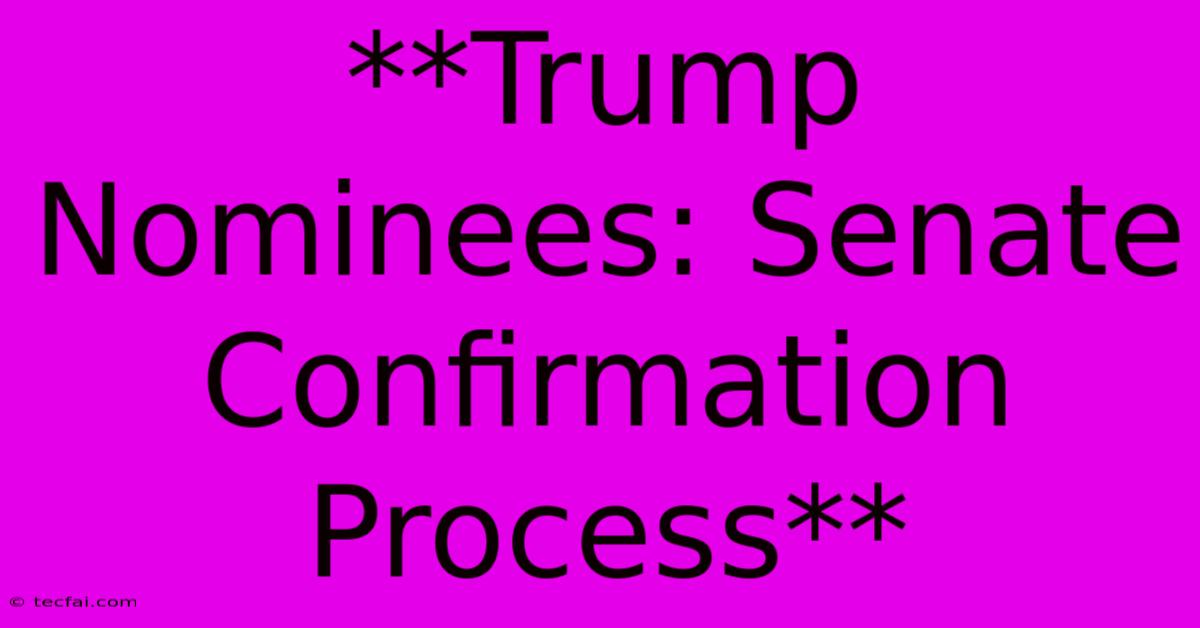**Trump Nominees: Senate Confirmation Process**

Discover more detailed and exciting information on our website. Click the link below to start your adventure: Visit Best Website tecfai.com. Don't miss out!
Table of Contents
Trump Nominees: Navigating the Senate Confirmation Process
The appointment of high-level officials, including cabinet members, judges, and ambassadors, is a crucial part of any presidential administration. These individuals shape policy, influence the judiciary, and represent the United States on the global stage. In the United States, the Senate holds the power to confirm or reject these nominees, a process that can be both complex and politically charged. This article delves into the Senate confirmation process, specifically focusing on how it unfolded during the Trump administration.
Understanding the Process
The Constitution grants the President the power to nominate officials, but those nominees must be approved by the Senate. This process is outlined in Article II, Section 2: "The President shall nominate, and by and with the Advice and Consent of the Senate, shall appoint Ambassadors, other public Ministers and Consuls, Judges of the Supreme Court, and all other Officers of the United States."
The confirmation process typically involves these steps:
- Nomination: The President formally nominates an individual for a specific position.
- Committee Hearings: The nominee appears before the relevant Senate committee to answer questions and discuss their qualifications.
- Committee Vote: The committee votes on whether to recommend the nominee to the full Senate.
- Senate Floor Debate: The Senate debates the nominee's qualifications and suitability for the position.
- Senate Vote: The full Senate votes on whether to confirm the nominee. A simple majority (51 votes) is needed for confirmation.
The Trump Administration: A Shift in Confirmation Dynamics
The Trump administration saw a significant shift in the Senate confirmation process, characterized by:
- Increased partisanship: The confirmation hearings were often contentious, with sharp divides along party lines.
- Rapid pace of confirmation: The Trump administration moved swiftly to nominate and confirm its cabinet and other key officials. This led to some concerns about the thoroughness of the vetting process.
- Controversial nominees: Several Trump nominees faced scrutiny and criticism, particularly those for judicial positions, leading to lengthy and heated debates.
Key Considerations in the Trump Era
- Judicial nominations: The Senate confirmation process took on particular significance during the Trump presidency due to the high number of judicial appointments. Trump appointed three Supreme Court justices and numerous federal judges, which had a lasting impact on the judiciary.
- Executive branch appointments: The rapid pace of confirmations for executive branch positions raised concerns about potential conflicts of interest and the lack of proper scrutiny.
- Political influence: The confirmation process became increasingly politicized, with senators often voting along party lines rather than on the merits of the nominee's qualifications.
Impact and Future Implications
The Senate confirmation process during the Trump administration had a significant impact on the composition of the federal government and the direction of public policy. It also set a precedent for future administrations, highlighting the potential for partisan gridlock and the growing influence of political considerations in the confirmation process.
This article provides a glimpse into the Senate confirmation process and its complex dynamics, particularly during the Trump presidency. It underscores the importance of this process in shaping the country's leadership and the challenges involved in balancing political considerations with the need for qualified and capable officials.

Thank you for visiting our website wich cover about **Trump Nominees: Senate Confirmation Process**. We hope the information provided has been useful to you. Feel free to contact us if you have any questions or need further assistance. See you next time and dont miss to bookmark.
Featured Posts
-
Recess Appointments Vetting Trumps Choices
Nov 15, 2024
-
Sweeney Fake Empowerment In Hollywood
Nov 15, 2024
-
Hydrogen Peroxide Spill Response Longueuil
Nov 15, 2024
-
Beaver Moon Meaning November 2024
Nov 15, 2024
-
Cobra Kai Season 6 Part 2 Ending Breakdown
Nov 15, 2024
